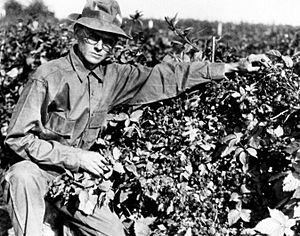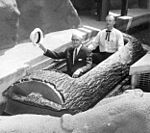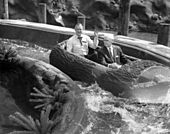Walter Knott facts for kids
Quick facts for kids
Walter Knott
|
|
|---|---|

Knott at his 60th anniversary in 1971
|
|
| Born | December 11, 1889 |
| Died | December 3, 1981 (aged 91) Buena Park, California, U.S.
|
| Resting place | Loma Vista Cemetery, Fullerton, California |
| Occupation | Farmer, amusement park owner, businessman |
| Years active | 1920–1974 |
| Known for | Founder of Knott's Berry Farm |
| Spouse(s) | Cordelia Hornaday (m.1911–1974; her death) |
| Children | 4 |
| Parent(s) |
|
Walter Knott (born December 11, 1889 – died December 3, 1981) was an American farmer and smart businessman. He is famous for starting Knott's Berry Farm, a popular amusement park in Buena Park, California. He also helped make the boysenberry fruit well-known and created the Knott's Berry Farm food brand.
Contents
Walter Knott's Early Life
Walter Knott was born on December 11, 1889, in San Bernardino, California. His father, Elgin Charles Knott, was a minister. His mother was Margaret Virginia Daugherty Knott.
When Walter was young, his father passed away. His mother then moved Walter and his brother to Pomona, California. From a very young age, Walter dreamed of becoming a farmer. He finished school at age 16, which was allowed in California back then, to start working.
Walter Knott's Career Journey
Starting as a Farmer
Walter was very good at growing crops. He would rent empty lots around Pomona to grow food. This helped his family earn money. In 1911, he married Cordelia Hornaday. At that time, he was working for a company that built with cement.
In 1913, Walter tried farming on his own in the Mojave Desert. This first try was not successful. He tried farming again in 1917 near Shandon, California. This time, he grew food for workers at a cattle ranch. He sold any extra food for profit. This farming business worked much better. Walter and Cordelia earned enough money to pay off all their debts. They became a main food supplier for the area.
Moving to Buena Park
In 1920, Walter teamed up with his cousin, Jim Preston, who also grew berries. They started farming 20 acres of land in Buena Park, California. By 1923, Walter set up a small stand to sell their berries. It was on Grand Avenue, which is now Beach Boulevard. They sold berries to local people and tourists going to the beach.
In 1927, Walter bought the Buena Park farm from his landlord. The next year, he built a new building on the farm. It had a berry market, a plant nursery, and a tea room. His wife, Cordelia, used their family kitchen to cook food for the tea room. She sold hamburgers, sandwiches, and pies.
When the Great Depression started in 1929, land prices dropped. Walter wisely started buying more land around his farm.
The Famous Boysenberry
In 1934, Walter introduced a special new fruit called the boysenberry. It was named after its creator, Rudolph Boysen. The year before, Walter had gotten pieces of Boysen's old berry plant. This plant was a mix of a blackberry, a red raspberry, and a loganberry. Walter planted and grew these pieces on his farm.
The plant grew huge berries! Walter started using the boysenberry in all his products. Cordelia also added it to her tea room menu. That same year, Cordelia had a great idea. She decided to serve fried chicken dinners at her tea room. The chicken was a huge hit! Over the next six years, the tea room grew into a full restaurant. People would often wait several hours in long lines to eat there.
Building an Amusement Park
To keep the waiting chicken dinner crowds entertained, Walter built some fun attractions. He added exhibits and shops. In 1940, he built a western ghost town on the property. Walter loved American history, especially the Old West. He bought buildings from old ghost towns in California, Arizona, and Nevada. These buildings were taken apart, moved to Buena Park, and put back together on the farm.
Over the next few years, Walter kept adding to the ghost town. He added a saloon show, a theater, and a full-size railroad. More attractions came later, like a San Francisco cable car and a place to pan for gold. There was also a stagecoach ride, the Calico Mine Train ride, and the Timber Mountain Log Ride. A Mexican-themed area was also added.
In 1968, the Knott family put a fence around the farm. They started charging an entry fee for the first time. That's when Knott's Berry Farm officially became an amusement park. Even after Disneyland Park opened nearby in 1955, Knott's Berry Farm continued to do very well. Walter Knott and Walt Disney were friendly with each other. They even dined together sometimes. They were both part of the first planning group for Children's Hospital of Orange County.
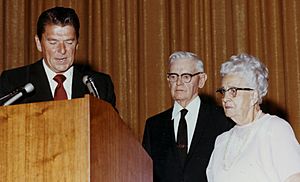
Later Years and Focus on Causes
Walter Knott stayed involved in running Knott's Berry Farm until his wife Cordelia passed away in 1974. After that, he let his children manage the park every day. He then spent his time supporting political causes.
Walter Knott's Death and Legacy
Walter Knott passed away on December 3, 1981, at his home in Buena Park, California. He was almost 92 years old. He is buried in Loma Vista Memorial Park in Fullerton, California.
Knott's Berry Farm is still open today, all year round. The Knott family owned the park until 1997. Then, it was sold to Cedar Fair Entertainment Company.
Walter Knott's Family Life
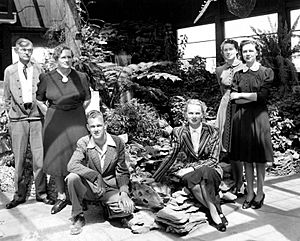
Walter Knott married his high school sweetheart, Cordelia Hornaday, on June 3, 1911. They had four children: Virginia, Russell, Rachel, and Marion.
After his wife's death in 1974, Walter focused on his beliefs. He believed that anyone could succeed through hard work. He also thought that government involvement was not always good. This idea of "rugged individualism" was important to him. Some people say the 'Old West' theme of his park showed these beliefs.
Walter was very interested in American pioneer history. In 1951, he bought and restored the real silver mining ghost town of Calico, California. As a child, Walter had spent a lot of time in Calico with his uncle. In 1966, he gave Calico to San Bernardino County.
Walter Knott even appeared on a TV show called You Bet Your Life in 1954. It was hosted by Groucho Marx.


